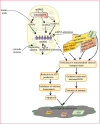The Role of Mitochondrial Genes in Neurodegenerative Disorders
- PMID: 34503413
- PMCID: PMC9881096
- DOI: 10.2174/1570159X19666210908163839
The Role of Mitochondrial Genes in Neurodegenerative Disorders
Abstract
Mitochondrial disorders are clinically heterogeneous, resulting from nuclear gene and mitochondrial mutations that disturb the mitochondrial functions and dynamics. There is a lack of evidence linking mtDNA mutations to neurodegenerative disorders, mainly due to the absence of noticeable neuropathological lesions in postmortem samples. This review describes various gene mutations in Alzheimer's disease, Parkinson's disease, amyotrophic lateral sclerosis, multiple sclerosis, and stroke. These abnormalities, including PINK1, Parkin, and SOD1 mutations, seem to reveal mitochondrial dysfunctions due to either mtDNA mutation or deletion, the mechanism of which remains unclear in depth.
Keywords: Alzheimer's disease; Parkinson's disease; amyotrophic lateral sclerosis; mtDNA; multiple sclerosis; neurodegeneration; stroke.
Copyright© Bentham Science Publishers; For any queries, please email at epub@benthamscience.net.
Figures


Similar articles
-
Mitochondria and neurodegeneration.Biosci Rep. 2007 Jun;27(1-3):87-104. doi: 10.1007/s10540-007-9038-z. Biosci Rep. 2007. PMID: 17486441 Review.
-
PINK1/PARKIN signalling in neurodegeneration and neuroinflammation.Acta Neuropathol Commun. 2020 Nov 9;8(1):189. doi: 10.1186/s40478-020-01062-w. Acta Neuropathol Commun. 2020. PMID: 33168089 Free PMC article. Review.
-
Neurodegenerative Diseases Associated with Mitochondrial DNA Mutations.Curr Pharm Des. 2020;26(1):103-109. doi: 10.2174/1381612825666191122091320. Curr Pharm Des. 2020. PMID: 31755379 Review.
-
Mitochondrial DNA (mtDNA) as fluid biomarker in neurodegenerative disorders: A systematic review.Eur J Neurol. 2025 Jan;32(1):e70014. doi: 10.1111/ene.70014. Eur J Neurol. 2025. PMID: 39831374 Free PMC article.
-
Mitochondrial pathobiology in Parkinson's disease and amyotrophic lateral sclerosis.J Alzheimers Dis. 2010;20 Suppl 2:S335-56. doi: 10.3233/JAD-2010-100348. J Alzheimers Dis. 2010. PMID: 20413846 Review.
Cited by
-
Neuroglobin overexpression in cerebellar neurons of Harlequin mice improves mitochondrial homeostasis and reduces ataxic behavior.Mol Ther. 2024 Jul 3;32(7):2150-2175. doi: 10.1016/j.ymthe.2024.05.030. Epub 2024 May 24. Mol Ther. 2024. PMID: 38796706 Free PMC article.
-
Genomic ncRNAs regulating mitochondrial function in neurodegeneration: a neglected clue in the complex etiopathogenesis of multiple sclerosis.Cell Biosci. 2025 Jun 28;15(1):93. doi: 10.1186/s13578-025-01438-2. Cell Biosci. 2025. PMID: 40581642 Free PMC article.
-
Medicinal Chemistry Studies Against Neurodegenerative Diseases.Curr Neuropharmacol. 2022;20(5):822-823. doi: 10.2174/1570159X2005220329113736. Curr Neuropharmacol. 2022. PMID: 35545969 Free PMC article. No abstract available.
-
A primordial target: Mitochondria mediate both primary and collateral anesthetic effects of volatile anesthetics.Exp Biol Med (Maywood). 2023 Apr;248(7):545-552. doi: 10.1177/15353702231165025. Epub 2023 May 19. Exp Biol Med (Maywood). 2023. PMID: 37208922 Free PMC article. Review.
-
The role of mitochondrial dynamics in disease.MedComm (2020). 2023 Dec 28;4(6):e462. doi: 10.1002/mco2.462. eCollection 2023 Dec. MedComm (2020). 2023. PMID: 38156294 Free PMC article. Review.
References
-
- Bender A., Krishnan K.J., Morris C.M., Taylor G.A., Reeve A.K., Perry R.H., Jaros E., Hersheson J.S., Betts J., Klopstock T., Taylor R.W., Turnbull D.M. High levels of mitochondrial DNA deletions in Substantia nigra neurons in aging and Parkinson disease. Nat. Genet. 2006;38(5):515–517. doi: 10.1038/ng1769. - DOI - PubMed
Publication types
MeSH terms
Substances
LinkOut - more resources
Full Text Sources
Medical
Miscellaneous

